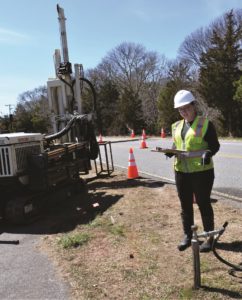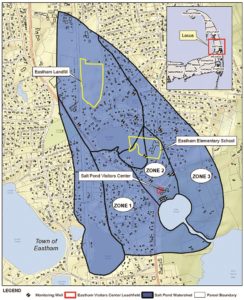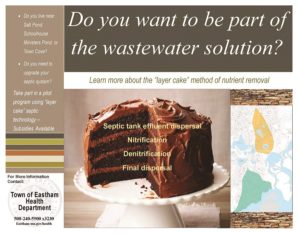EASTHAM — Those weren’t frackers drilling for oil last week along Nauset Road at the Salt Pond Visitor Center. Instead, workers were injecting emulsified vegetable oil as a permeable reactive barrier (PRB) to change the chemistry of groundwater flowing to Salt Pond.

The work is just one element of a many-pronged effort to reduce contaminants in the Nauset-Town Cove and Rock Harbor estuaries and its freshwater ponds. Rather than pursue what director of health and environment Jane Crowley calls the “expensive and arduous” traditional approach of sewering, Eastham is looking to options such as PRBs, innovative and alternative septic systems, tighter fertilizer regulation, and pond remediation.
“We generally have focused on the Salt Pond subwatershed that feeds into the Nauset Harbor estuary,” Crowley said. “It’s completely within Eastham and lends itself to trying as many nontraditional strategies as we can to improve water quality at Salt Pond.”
Near the subwatershed’s top sits the town landfill, above Schoolhouse and Minister’s ponds, two lobes of a connected water body. Groundwater flow continues past Eastham Elementary School and private homes with septic systems across Nauset Road to the visitor center and Salt Pond.
Contaminants leaving the landfill led to the provision of municipal water service in the area, allowing residents to abandon private wells. “The hookup and any costs associated with connecting to municipal water were paid by the town,” Crowley said. “The impact from the landfill is no longer a threat to the drinking water of residents downgradient.
“The hydrogeology we know about this particular subwatershed is immense,” Crowley said. “There are so many monitoring wells.” Those data informed other efforts to improve water quality, including a 200-foot PRB pilot project along Nauset Road installed by Environmental Strategies and Management (ESM).
“There are 21 points where emulsified vegetable oil has been injected,” said Crowley. “We know exactly the depth of the zone we are trying to treat and have several groundwater quality monitoring wells upgradient and downgradient. As the nutrient flow comes from upgradient areas and passes through this barrier, the reactive materials hopefully will help to biodegrade the contaminants and improve the water quality before discharge to Salt Pond.”

Orleans has installed a PRB at the Nauset Regional Middle School. According to ESM, that PRB “is achieving nitrate treatment objectives.”
With groundwater traveling about a foot a day, it will be some time before measurable effects are recorded in Eastham. But there’s more going on, including what Crowley hopes will be DEP approval this week for a pilot innovative/alternative septic system with superior denitrification capabilities. The “layer cake” system includes a layer of sawdust and sand under the leaching field.
The nonproprietary system would be installed on a property in the Nauset Harbor estuary system, just upgradient of a data-collection site. The owner “came before the board of health because he needed a variance,” said Crowley. “He would have been required to put in an alternative treatment system anyway. We are subsidizing some of the cost. The home owner was a very willing partner. He strongly believes in what we’re trying to do.
“This is a really exciting opportunity for the town of Eastham. If we can reduce nitrogen with this approach, it will be the most cost-effective for the community and the home owner.” She said construction of the pilot system would begin “immediately” after DEP approval.
Elsewhere, attention is being paid to the Schoolhouse-Minister’s pond complex, with hydroraking of excessive growths of aquatic plants last fall. “This spring, we’re working on an aeration system to go into the pond from the back of the elementary school,” Crowley said. “We’ll continue to monitor water quality and test sediments and do vegetation surveys. If necessary, we’ll determine if we need alum treatments in very limited areas,” basically the deepest portions.
The District of Critical Planning Concern that Eastham created with the Cape Cod Commission brought fertilizer regulations that restrict, for example, the time of year applications can be made. If they’re done before April 15, they cannot be absorbed and contribute to runoff. “To be very honest, I think Eastham is a different type of community than perhaps the more developed ones like Barnstable where you tend to see more fertilized lawns,” Crowley said. “I think this community does have a big appreciation of the negative impacts of improper fertilizer uses.”

Another denitrification method, using shellfish to reduce levels in ponds, is “still in development,” said Crowley. The town is keeping an eye on Orleans’s experiment in Lonnie’s Pond, which has shown promise.
Today, Crowley said, Salt Pond is “definitely impaired, significantly impaired. We know that didn’t happen overnight. We don’t expect any measures we put into place to happen overnight either. These strategies are really important for the long term. To do nothing is not the answer.”



